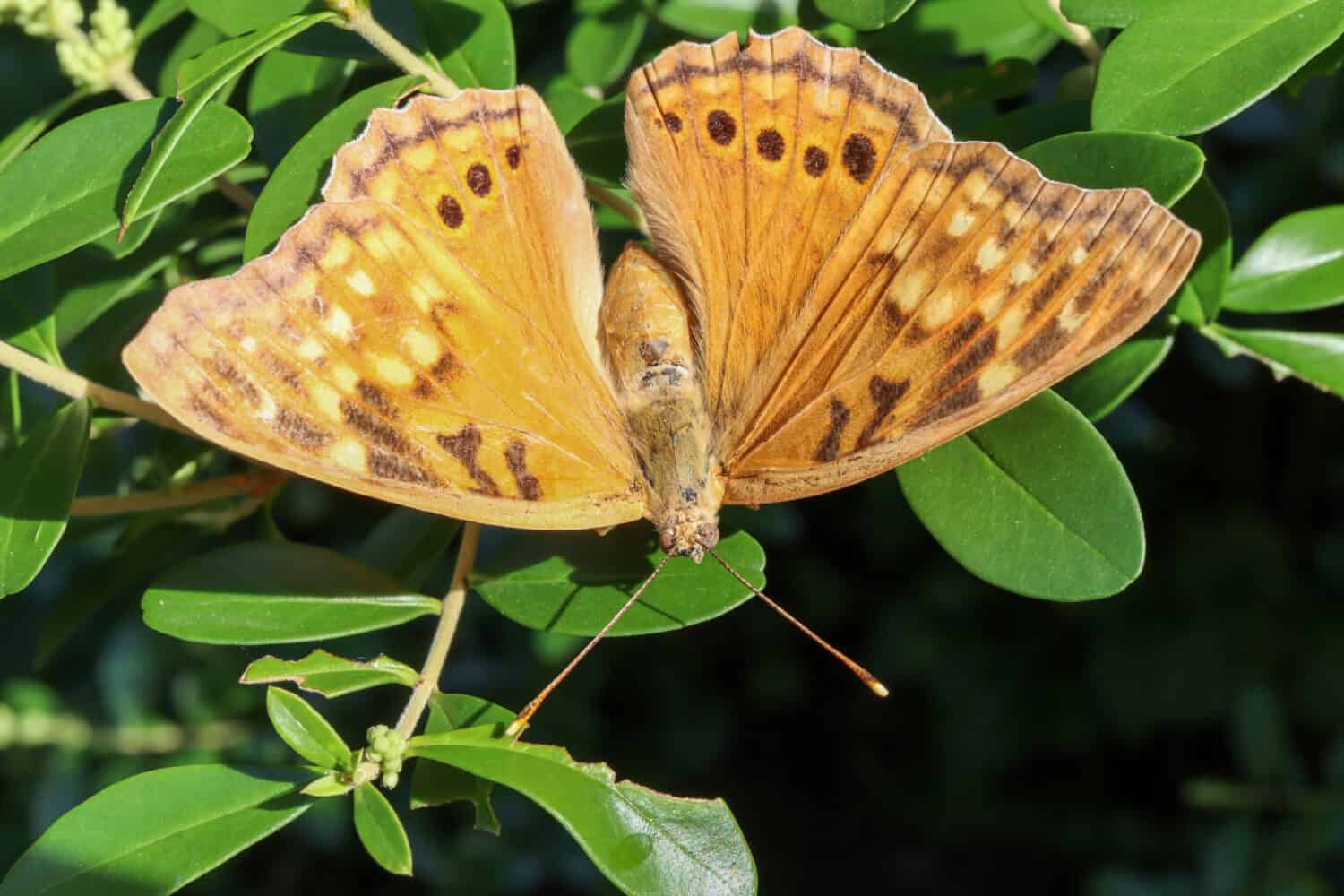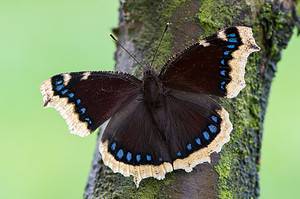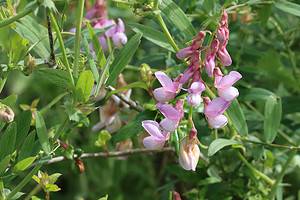If you’ve ever stopped to watch a butterfly flutter by, you know how captivating they can be. Ohio is home to many different fantastic butterfly species that will leave you in awe. These winged beauties are a wonder to behold, from the magnificent Monarch to the elegant Black Swallowtail.
Whether you’re an avid butterfly watcher or a curious beginner, Ohio’s butterfly population of 150 species will surely fascinate you. So, take a moment to appreciate the wonders of nature and explore the magical world of Ohio’s butterflies. You never know what secrets and joys you might discover.
How Many Butterfly Species Are There In Ohio?
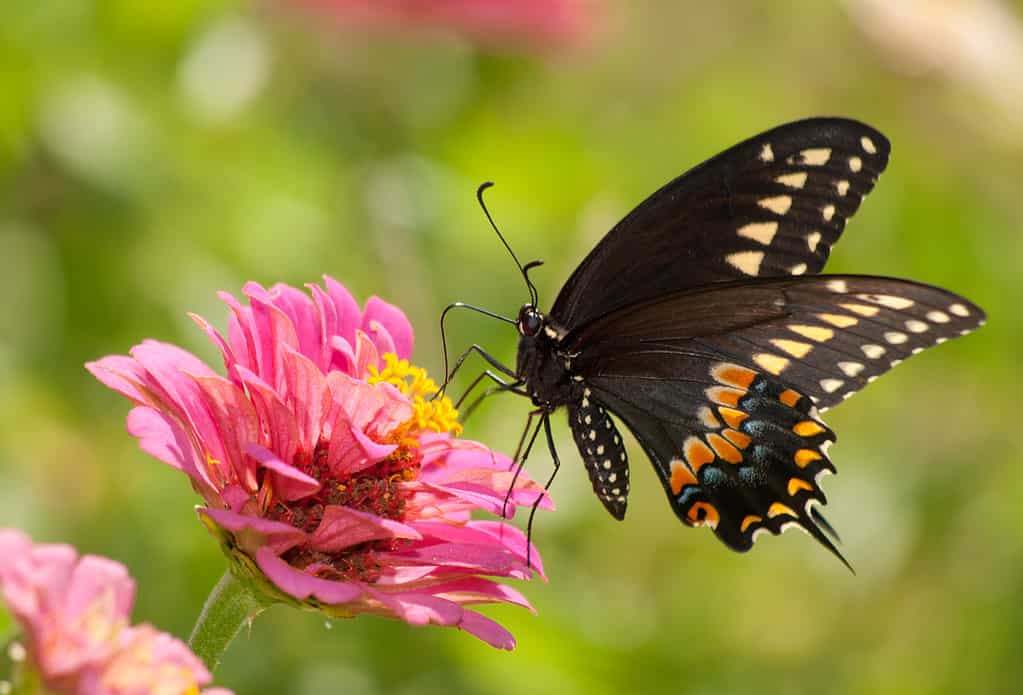
The eastern black swallowtail butterfly.
©Sari ONeal/Shutterstock.com
There are nearly 18,000 butterfly species in the world and around 750 in the United States. Ohio is home to between 120-160 different butterfly species at any given time, depending on the season, weather patterns, population trends, and other environmental factors. It is important to note that butterfly populations fluctuate year to year as the animals are very susceptible to changes in weather conditions, pollution, agriculture, invasive species, etc. The use of pesticides and herbicides to kill of unwanted animals and weeds can either directly or indirectly harm butterflies as the pesticides can kill insects and herbicides can kill off important food sources for these animals.
Scientists estimate that butterfly populations will continue to decline worldwide. 8 of Ohio’s 120-160 butterfly species are endangered, and several are near extinction. For example, migratory Monarch butterflies saw an 80-90% decrease in their population over the last few decades due to climate change and other factors.
1. Zebra Swallowtail (Eurytides Marcellus)
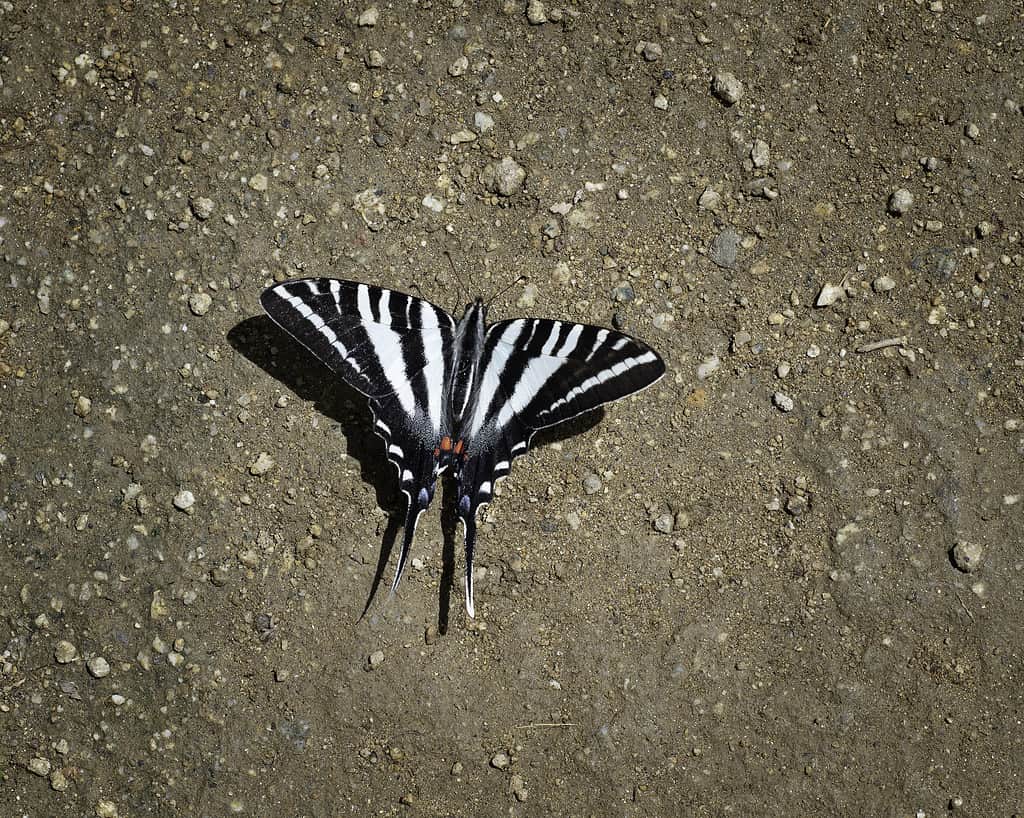
A close-up of a Zebra Swallowtail (
Eurytides Marcellus) butterfly.
©iStock.com/GDMatt66
The zebra swallowtail butterfly is a familiar sight in Ohio, distinguished by its unique physical characteristics. Its wings have black zebra-like stripes on a whitish background and are long and triangular. They have a wingspan between 2 to 4 inches. The butterfly has two blue spots, elongated tails at the wingtips, and red spots near the lower part of its body.
This exquisite butterfly species lives in damp, wooded areas close to swamps and rivers, as well as brushy regions or open fields. The adult zebra swallowtails feed on nectar from various flowers such as redbud, milkweed, and verbena, while the caterpillars prefer paw paw leaves.
Male zebra swallowtails can be seen patrolling for females and flying low along woodland trails within their natural habitats. In addition, males congregate on wet roads, riverbanks, and mud puddles, to drink water. The zebra swallowtail is a member of the kite swallowtails, which is a tropical genus that derives its name from the shape of its wings.
2. Butterflies That Live in Ohio: Orange Sulfur (Colias eurytheme)
Identifying the orange sulfur in Ohio can be a challenging task. The wings’ upper surface typically displays a vibrant orange hue, but some females may exhibit white wings. On the hindwing’s underside is a silver spot enclosed by two red rings and a satellite spot. Males’ wings reflect ultraviolet light on the upper surface, caused by a recessive gene on the X chromosome. The orange sulfur uses its vision to find potential mates.
This species has a wingspan of approximately one and three-fourth to two and a half inches and can be observed in open areas such as pastures, roadsides, vacant lots, fields, and alfalfa fields, where they are also referred to as alfalfa butterflies.
The adult orange sulfur butterfly engages in several different feeding behaviors, including sipping from mud puddles and taking nectar from different plant species. Some of the plants they feed on include clovers, alfalfa, selfheal, and milkweeds.
They also feed on various pea family (Fabaceae) species and are most active at night. These butterflies tend to gather in small groups near the ground during nighttime roosting. In some cases, their population multiplies to high numbers and can cause significant damage to alfalfa (Medicago sativa) crops.
3. Butterflies That Live in Ohio: Summer Azure (Celastrina neglecta)

Some females of
Celastrina neglectahave a white appearance instead of blue, but you can see a hint of blue at the base of their wings.
©BernadetteB/Shutterstock.com
During the summer months in Ohio, you may catch a glimpse of the summer azure butterfly, typically seen in or after July.
The males are pale blue in color with a light dusting of white scales covering all four wings when they are open. Some females have a white appearance instead of blue, but you can see a hint of blue at the base of their wings. Females often have a wide, dark grey band on the costa and the outer third of their forewings.
These butterflies have an average wingspan of 0.91-1.14 inches, and unlike other azures, they are not limited to woodlands. You can often find them in partially open areas such as powerline right-of-ways, streamsides, forest edges, and gardens. They feed on the nectar of various flowering plants, such as early-blooming milkweeds, dogbanes, and wild plums. Blue azure caterpillars feed on the flowers and fruits of nonwoody and woody plants.
Male summer azures are most active in the afternoons and evenings, searching for females and keeping other males at bay. Females lay single eggs on the flower buds of various woody host plants. Sadly, these beautiful creatures have a brief lifespan, living for only a few days.
4. Butterflies That Live in Ohio: Edwards’ Hairstreak (Satyrium edwardsii)
The Edwards’ hairstreak is a butterfly species currently at extinction risk. Luckily, it can be found in the prairie region of Adams Lake, Ohio.
This butterfly has a wingspan ranging from 1 to 1 ½ inches. Its hindwing’s underside is a pale brown color, featuring a postmedian band consisting of dark brown oval spots instead of dashes. Although the blue tail spot is usually not topped with orange, some red scales may sometimes be visible.
Edwards’ hairstreak butterflies thrive in diverse habitats such as limy ridges, sand barrens, savannahs, and the openings and borders of oak thickets. During their adult stage, they feed on nectar from a range of milkweeds, dogbane, legumes, sumac, and other summer flowers.
The males typically perch on trees to search for potential mates, while the females lay their eggs in the bark crevices of young host trees. During the day, young caterpillars consume buds, while older caterpillars feed on leaves at night and seek refuge during the day in ant nests situated at the base of the host tree. The caterpillars provide ants with honeydew; in exchange, the ants offer protection from predators.
5. Butterflies That Live in Ohio: American Cooper (Lycaena phlaeas)
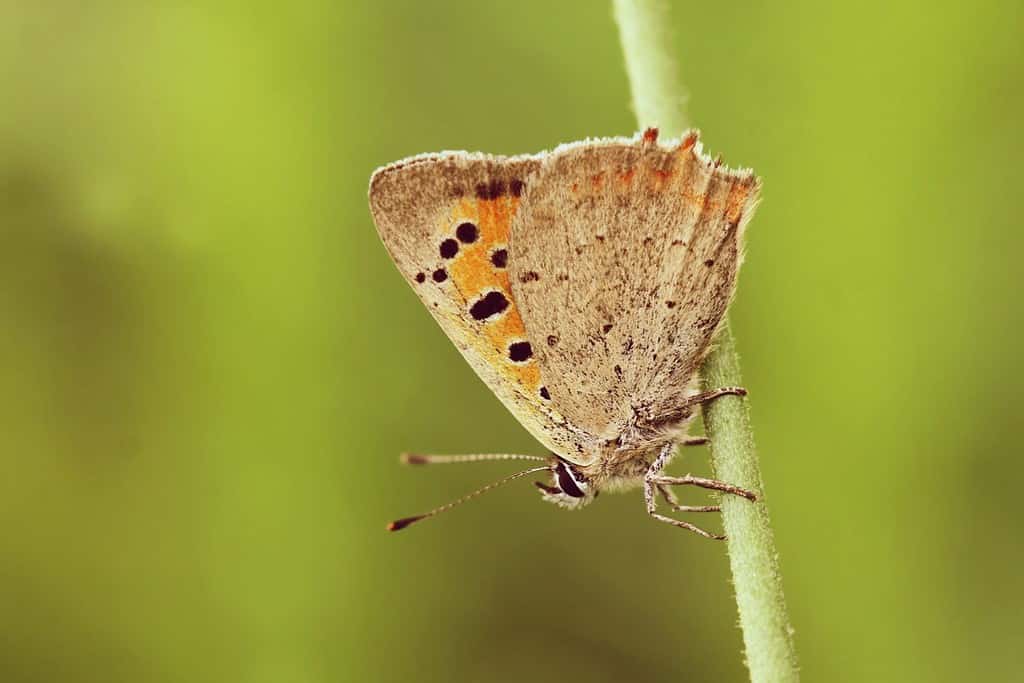
Female American coppers are slightly bigger and have larger spots on their forewings.
©Monika Surzin/Shutterstock.com
The American copper butterfly is a frequently spotted species throughout North America, including in Ohio. Its wingspan ranges from 1 to 1¼ inches, and the forewings are adorned with black spots and dark margins against an orange backdrop. Meanwhile, the hindwings boast a gray-brown color with an orange band featuring a row of black spots.
Female American coppers are slightly bigger and have larger spots on their forewings. The butterfly’s wings are light gray on the underside, with small black flecks and a red-orange line on the outer hindwing.
These butterflies can be found in open areas, especially those that have been disturbed, as long as their host plant is present. They are drawn to gardens filled with nectar-rich flowers such as mountain mints, mistflower, and butterfly weeds. The American copper butterfly is most commonly seen during May, July, and late summer/early fall, even though it is active from early April to early November.
Adult butterflies drink nectar from common buttercup, goldenrod, yarrow, and white clover. Male American coppers are known for their aggressive behavior when pursuing females. They focus solely on mating, taking brief breaks to feed on small flowers.
6. Butterflies That Live in Ohio: Cabbage White (Pieris rapae)
The cabbage white is a common butterfly species found in Ohio. It has a wingspan of 1¼ to 1¾ inches and is predominantly white in color, with charcoal black tips on its forewings and 1 or 2 black spots on its forewings. The species exhibits seasonal dimorphism, with spring and late fall individuals being smaller, less yellow, and having reduced black markings.
In Ohio, the cabbage white butterfly can be found in various habitats such as forests, woodlands, heath, and urban areas. As a caterpillar, it feeds on cabbage, whereas an adult butterfly primarily feeds on nectar from flowers. In captivity, the species can be fed with sugar water.
The cabbage white butterfly is active during the daytime and flies from early spring through fall or early winter, with overwintering being determined by temperature rather than day length. It is diurnal and does not fly during dawn and evening. Male cabbage whites repeatedly search for females by patrolling the same small areas. They also gather on wet roads or muddy areas to obtain moisture and minerals.
7. Butterflies That Live in Ohio: Appalachian grizzled skipper (Pyrgus centaureae wyandot)
Sadly, the Appalachian grizzled skipper population in Ohio has declined to such an extent that the state has classified it as an endangered species.
The butterfly is identifiable by its gray and brown coloring, with white checkered markings on its wings and wing edges. The skipper’s size ranges from 1.14 to 1.3 inches.
These butterflies fly close to the ground, usually less than three feet high, in an erratic and quick pattern. It can be challenging to spot while in flight due to its drab coloring, which blends with the surrounding terrain. When threatened, it tends to hide in vegetation to avoid predators.
This butterfly is commonly found in open areas with low vegetation near oak or pine forests. Adult butterflies feed on nectar from various sources, while caterpillars feed on several plants, such as bramble, wild strawberry, agrimony, creeping cinquefoil, and salad burnet.
The Appalachian grizzled skipper is a species of concern at the federal level, and Ohio and New Jersey have both designated it as an endangered species.
8. Northern Metalmark (Calephelis borealis)
The Northern metalmark is a butterfly species found throughout the Ohio River Valley and the central Appalachians. This butterfly is a subtle beauty, with its wings displaying rust, silver, and metal patterns on a dark background. The male’s forewings are rounded, and both wings feature wide orange borders and a dark median band.
While the northern metalmark and swamp metalmark may look similar, their habitat requirements set them apart when their ranges overlap. These butterflies have a wingspan of 1 1/8 to 1 1/4 inches.
Adult Northern metalmarks feed on nectar from various flowers like white sweet clover, butterflyweed, ox-eye daisy, yarrow, goldenrod, and sneezeweed. They can be found near open woodland streams located near serpentine or limestone barrens.
Typically, adults perch on the underside of leaves of shrubs or small trees, basking in sunny spots or on flowers. They may travel short distances from their primary habitats in search of nectar or for other reasons. These butterflies are most active during summer, making it the ideal time to observe them.
9. Gulf Fritillary (Agraulis vanillae)

This butterfly species thrives in sunny environments in fields, open woodlands, pastures, and parks.
©A. Viduetsky/Shutterstock.com
The Gulf fritillary is a butterfly species with elongated forewings and is medium size. Typically, their wingspan ranges from 2.5 to 3.7 inches, with females being slightly larger than males. Both sexes exhibit distinct differences in their physical appearance. The wings’ upper surface is bright orange, adorned with black markings, with females being more marked and dark. The forewing cell features three black-rimmed white spots.
This butterfly species thrives in sunny environments in fields, open woodlands, pastures, and parks. To sustain themselves, they primarily feed on nectar from native plants such as lantana, red clover, thistle, and phlox. They also need access to water, which they can obtain from nectar-producing plants or through small shallow ponds.
In their mating rituals, male Gulf fritillaries perform a “wing clap display” to attract their female counterparts. During this display, the male perches and repeatedly opens and shuts its wings as a form of demonstration for the female. Additionally, they release pheromones, chemicals the female can recognize, to entice them further.
10. Hackberry Emperor (Asterocampa celtis)

These butterflies are found in diverse habitats such as streams, edges of rivers, wooded roadsides, forest glades, and even towns.
©John_P_Anderson/Shutterstock.com
From late spring to fall, Ohio is home to the hackberry emperors, which exhibit various physical traits depending on their location. When their wings are open, they display a reddish-brown or tan hue with a submarginal eyespot and a row of jagged white spots. The wings also have black bars and spots in each cell. When closed, the patterns are similar but with lighter hues. The male Hackberry Emperors have slimmer wings and darker bodies and are smaller than their female counterparts. Their wingspan is between 1.3 to 2.5 inches.
These butterflies are found in diverse habitats such as streams, edges of rivers, wooded roadsides, forest glades, and even towns. Their adult diet includes feces, hackberry sap, hackberry flower nectar, dead animals such as decaying pigs, snakes, and dogs, and old fruit.
The hackberry emperors prefer to perch on trees in woodlots, parks, and gardens and are known for their territorial and aggressive nature. If a brown butterfly lands on you, it is likely a hackberry emperor. These butterflies are also attracted to the sodium in human sweat and are known to alight on people.
Butterflies That Live in Ohio: Where to See Them
Here are some of Ohio’s best places to see different butterfly species.
- Butterfly House in Toledo
Admission: $8.
Attraction: It has over 100 species from all over the world. - Beech Creek Gardens Butterfly House
Admission: $9
Attraction: It Has over 23 butterfly species native to Ohio. - Butterfly House At Put-In-Bay
Admission: $10
Attraction: It has over 50 species of butterfly and is the largest butterfly house in the state of Ohio. - Butterfly Ridge
Admission: $6
Attraction: Over 21 acres of land serving to protect and conserve butterflies. - Shawnee State Park
Admission: Free
Attraction: Gorgeous state park with hiking trails, hills, forests, and wildlife. Between April and July, you have a good chance of spotting many native butterfly species.
Thank you for reading! Have some feedback for us? Contact the AZ Animals editorial team.

